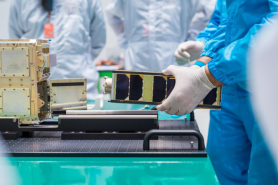
GOHEUNG, South Korea, November 27 (AJP) - South Korea opened a new chapter in its space program Thursday with the successful fourth launch of the homegrown Nuri rocket — the first assembled by Hanwha Aerospace — marking a decisive shift toward a private sector–driven space industry.
The 200-ton, three-stage rocket lifted off from the Naro Space Center at 1:13 a.m. and entered a sun-synchronous orbit 600 kilometers above Earth, deploying a next-generation medium satellite along with 12 cube satellites. The flight was completed in 18 minutes and 52 seconds, faster than the planned 21 minutes and 24 seconds, after its engines outperformed design specifications, according to Park Jong-chan of the Korea Aerospace Research Institute (KARI).
The medium satellite made first contact with Antarctica’s King Sejong Station 42 minutes after launch, with further communications scheduled with ground stations in Daejeon and Norway’s Svalbard.
Deputy Prime Minister Bae Kyung-hoon called the mission a “pivotal moment” as the country transitions from a government-led model to a private sector–driven space economy. “South Korea is committed to becoming a top-five space power, with ambitions stretching from lunar exploration to deep space,” he said.
For the first time, Hanwha Aerospace led the manufacturing and assembly of Nuri, following a technology transfer agreement with KARI earlier this year. The transfer, valued at 24 billion won (US$16.2 million), gives Hanwha exclusive rights to produce and operate Nuri through 2032, covering design, manufacturing and launch operations. Launchpad and propulsion-test infrastructure remain under government control.
Compared with Nuri’s third launch in May 2023, which reached 550 km and carried 500 kg of payloads, Thursday’s mission flew higher and carried 960 kg — nearly double the earlier load.
Experts say the launch is a watershed moment in Korea’s emergence into the “new space” era.
“This marks the true beginning of private-sector-led space development,” said Huh Hwan-il, aerospace engineering professor at Chungnam National University. “Japan transferred launch vehicle technologies to industry two decades ago, and Mitsubishi Heavy Industries now leads that market. Korea must prepare similar institutional groundwork to help companies fully utilize government-built capabilities.”
The Korea Space Agency said it plans the fifth and sixth Nuri flights in 2026 and 2027, followed by a seventh in 2028. “We are planning next year’s budget to begin developing a next-generation launch vehicle building on Nuri’s technology,” said agency head Yoon Young-bin.
South Korea’s steady push toward commercial space development — with Nuri now transitioning from state laboratories to private hands — positions the country to accelerate toward its long-term goal of joining the global top tier of space powers.
* This article, published by Aju Business Daily, was translated by AI and edited by AJP.
Copyright ⓒ Aju Press All rights reserved.



![[K-Tech] Hanwha Aerospace nears Nuri rocket technology transfer deal](https://image.ajunews.com/content/image/2025/07/23/20250723143507887407_278_163.jpg)